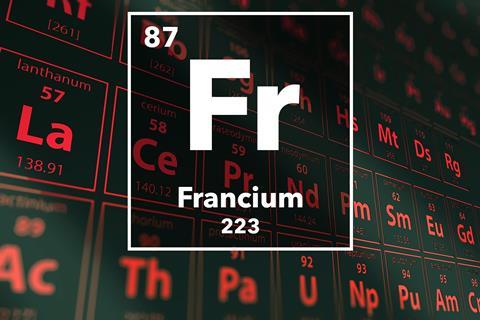Chris Smith
This week, we're hunting for the chemical that was named after France. But you'll need very good eyesight because there's less than a kilogram of it across the entire earth. Know what it is yet? Here's Peter Wothers.
Peter Wothers
In 1929, Madame Curie hired a newly-qualified, twenty-year old technician, Marguerite Catherine Perey, to act as her lab assistant. Ten years later, this remarkably skilled woman discovered the much sought after element francium. As a result, she was encouraged to study for a degree, and then for her PhD. Despite the fact that her mother was convinced she would fail, in March 1946 Perey successfully defended her thesis on Element 87. Sixteen years later, she became the first woman to be elected a member of the French Academy of Sciences, an honour not even awarded to her mentor Madame Curie.
But the story of element 87 begins much earlier than its discovery date in 1939. When Mendeleev first proposed his periodic table in 1869 he left gaps for elements not yet discovered, but that he predicted should exist. One such gap was one beneath caesium, a position later found to belong to francium.

More than 40 years later, it was suggested that each element has a unique numbered position in the periodic table, known as its atomic number. Physicist Henry Moseley proved the existence of the "atomic number" and also suggested that it represented the number of positively-charged protons in the nucleus of the atom. Once the atomic numbers for all the known elements were assigned, it was clear seven elements were missing from the periodic table between hydrogen with atomic number 1, and uranium, number 92. Francium, number 87, was the last of these elements to be discovered in nature.
From its position in the table, it was clear that element 87 would be a reactive alkali metal, the heaviest member of the family lithium, sodium, potassium, rubidium and caesium. Consequently, many researchers started looking for the new metal in ores which contained these related elements. Many false claims were made before it was realised that the missing element would be radioactive with no stable form. Then the search focused on looking at the decay sequences of other radioactive elements.
Two simple rules dictate what elements are formed in a decay series. For each alpha particle a radioactive sample emits, the atomic number of the product element formed is two less than the element from which it formed. For each beta particle emitted, the atomic number of the product increases by one. The element with atomic number 89, two places to the right of our 87, is actinium which had been discovered in 1899.

Studying decay products is not an easy task and Perey's skill allowed her to swiftly purify a sample of an actinium salt so she could observe only the emissions from this element. She eventually realised that most actinium (almost 99% in fact) slowly decays with the emission of a beta particle, forming element 90, thorium. This then decays by emitting an alpha particle to form element 88, radium. However, about 1% of the actinium doesn't do this and instead emits an alpha particle to form the missing alkali metal element 87. This was made even more difficult to spot by the fact francium has a half life of just 21 minutes, because it quickly emits a beta particle to once again form radium.
During these initial investigations, Perey referred to her element as actinium-K; a reference to the route by which it is formed. However, she needed a proper name for her element. During her PhD exam, she suggested the name "catium" since she thought it would be the metal that most readily loses an electron to form a cation. Fortunately, this name was met with little enthusiasm – one of her examiners even suggested that English-speaking people might think it was named after a cat. Perey then suggested the name Francium, after her native country, and this name was accepted.
Whilst it is naturally occurring, or to be more precise, naturally formed – albeit briefly – during radioactive decay of other elements, the amount of francium on earth is tiny. It has been estimated that at any one time there is less than a kilogram of the element in the entire Earth's crust. What's more, to the surprise of most chemists and going against the well-known trends of the periodic table, it turns out that francium is not the most reactive metal. On descending a group in the periodic table, on average the outermost electrons get further and further away from the nucleus and as a result, become easier to remove from the atom. This is the trend for the elements lithium, sodium, potassium, rubidium and caesium. However, for the really heavy elements, the presence of so many positively charged protons in the nucleus has the affect of causing the electrons to move round at incredibly fast speeds approaching the sound of light. As Einstein realised at such speeds strange things being to happen. The electrons become a little closer to the nucleus than expected and they also become slightly harder to remove than expected.
Remarkably considering its short half-life, it has been possible to measure experimentally the energy needed to remove an electron from francium to form a positively charged francium cation. The energy needed is 393 kJ mol -1 some 17 kJ mol-1 more than for caesium. This means that francium is not the metal that most easily forms a cation, as Perey was suggesting with her proposed name catium; this honour goes to francium's lighter family member, caesium.
Chris Smith
So the experiment that we all wanted to do at school and drop a lump of Francium into wouldn't have actually been that impressive after all. I'll just stick to caesium then. Next week, you say tomato, I say tomato, but when it comes to element number 13, who's actually right?
Kira Weissman
Sir Humphrey Davy, the Cornish chemist who discovered the metal, called it 'aluminum', after one of its source compounds, alum. Shortly after, however, the International Union of Pure and Applied Chemistry (or IUPAC) stepped in, standardizing the suffix to the more conventional 'ium'. In a further twist to the nomenclature story, the American Chemical Society resurrected the original spelling in 1925, and so ironically it is the Americans and not the British that pronounce the element's name as Davy intended.
Chris Smith
And you can catch up with the story of the substance that's given us super light aircraft and the eponymous drink can on next week's Chemistry in its Element. I'm Chris Smith, thank you for listening and goodbye.













No comments yet